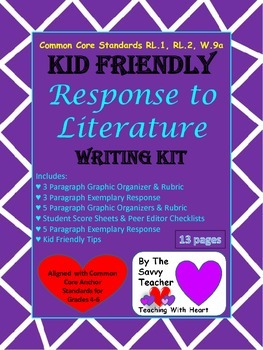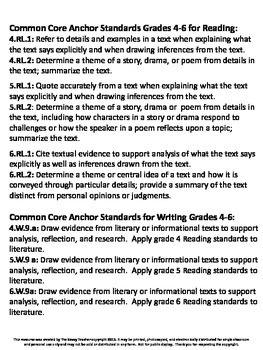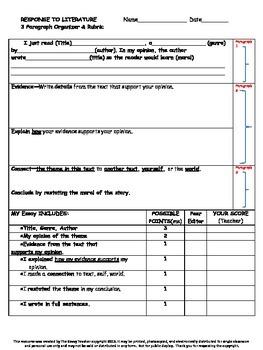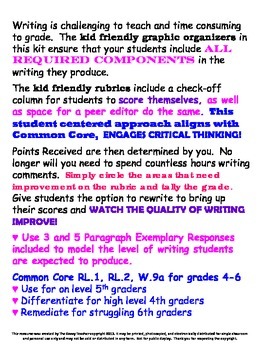Response to Literature Common Core Kid Friendly Writing Kit Bundle
Savvy Teacher
86 Followers
Grade Levels
4th - 6th, Homeschool
Subjects
Resource Type
Standards
CCSSRL.4.1
CCSSRL.4.2
CCSSRL.5.1
CCSSRL.5.2
CCSSRL.6.1
Formats Included
- PDF
Pages
13 pages
Savvy Teacher
86 Followers
Description
Common Core Standards inspire and require teachers to move our students toward a focus on thinking and taking ownership of their own learning. The Kid Friendly graphic organizers, rubrics, student score sheets, 3 and 5 paragraph exemplary essays, and peer edit checklists in this kit support students as they learn to do just that, preparing them for career and college readiness in the 21st Century!
Writing is challenging to teach and time consuming to grade. The pages in this kit ensure that your students include all required components in the writing they produce.
The kid friendly rubrics include a check-off column for students to score themselves, as well as space for a peer editor do the same. This student centered approach aligns with Common Core, ENGAGES CRITICAL THINKING!
Points Received are then determined by you. No longer will you need to spend countless hours writing comments. Simply circle the areas that need improvement on the rubric and tally the grade. Give students the option to rewrite to bring up their scores and WATCH THE QUALITY OF WRITING IMPROVE!
Includes:
♥ 3 Paragraph Graphic Organizer & Rubric
♥ 3 Paragraph Exemplary Response
♥ Two 5 Paragraph Graphic Organizers & Rubric
♥ Student Score Sheets & Peer Editor Checklists
♥ 5 Paragraph Exemplary Response
♥ Kid Friendly Tips
Common Core RL.1, RL.2, W.9a for Grades 4 - 6
♥ Use for on level 5th graders
♥ Differentiate for high level 4th graders
♥ Remediate for struggling 6th graders
COMMON CORE ANCHOR STANDARDS FOR READING GRADES 4 - 6:
4.RL.1: Refer to details and examples in a text when explaining what the text says explicitly and when drawing inferences from the text.
4.RL.2: Determine a theme of a story, drama, or poem from details in the text; summarize the text.
5.RL.1: Quote accurately from a text when explaining what the text says explicitly and when drawing inferences from the text.
5.RL.2: Determine a theme of a story, drama or poem from details in the text, including how characters in a story or drama respond to challenges or how the speaker in a poem reflects upon a topic; summarize the text.
6.RL.1: Cite textual evidence to support analysis of what the text says explicitly as well as inferences drawn from the text.
6.RL.2: Determine a theme or central idea of a text and how it is conveyed through particular details; provide a summary of the text distinct from personal opinions or judgments.
COMMON CORE ANCHOR STANDARDS FOR WRITING GRADES 4-6:
4.W.9.a: Draw evidence from literary or informational texts to support analysis, reflection, and research. Apply grade 4 Reading standards to literature.
5.W.9 a: Draw evidence from literary or informational texts to support analysis, reflection, and research. Apply grade 5 Reading standards to literature.
6.W.9a: Draw evidence from literary or informational texts to support analysis, reflection, and research. Apply grade 6 Reading standards to literature.
♥ The organizer for writing a 3 paragraph response to literature included in this kit is useful when introducing the skill--worth 10 points for easy scoring.
The 3 paragraph organizer is followed by a combination checklist/score sheet for the student and a peer editor to complete before turning the draft in for an initial score from the teacher. I recommend requiring students to rewrite their essay at least twice before recording a final grade.
THE 3 PARAGRAPH ORGANIZER works best with shorter literary works and can be used in class or as homework for additional practice.
♥ Distribute the handy RESPONSE TO LITERATURE TIPS to illustrate for your students how to choose specific details and make clear connections that support their analysis of the text.
♥ Two versions of graphic organizers for writing a 5 paragraph response to literature are included, each worth 20 points for easy scoring.
THE 5 PARAGRAPH ORGANIZERS work well for both short and longer literary works.
The first version is meant to be used for a first rough draft. It is a roomier format, especially beneficial for those students who require more space to get their thoughts onto paper.
Each paragraph of this organizer is followed by a checklist and a separate score sheet for the student and a peer editor to complete before turning the draft in for an initial score from the teacher.
The second 5 paragraph organizer includes the same information in a lined format, similar to writing on composition paper. This organizer is useful to use for a second draft, along with the two page student friendly rubric that requires students to go line by line, closely examining their essay for each of the required components bulleted in kid friendly terms on the rubric.
Each 5 paragraph organizer is structured to require students to provide 3 separate evidences from the text, explanations of how the evidence supports their interpretation of theme, and a connection (text to text, self, or world)—one for each of the three body paragraphs—making for a more in-depth analysis than required on the 3 paragraph organizer.
♥ Use the exemplary 3 and 5 paragraph essays provided to model the type and quality of writing students are expected to produce.
REMEMBER TO RATE THIS PRODUCT TO EARN TPT CREDITS FOR YOUR FUTURE PURCHASES!
Let me know of any questions. I am happy to help!
Thank you for choosing this product!
If you like this writing resource, check out the following:
Persuasive Common Core Kid Friendly Writing Kit
Copyright 2013 The Savvy Teacher
All Rights Reserved by the author.
Permission to copy for single classroom use only.
Electronic distribution limited to single classroom use only.
Not for public display.
Writing is challenging to teach and time consuming to grade. The pages in this kit ensure that your students include all required components in the writing they produce.
The kid friendly rubrics include a check-off column for students to score themselves, as well as space for a peer editor do the same. This student centered approach aligns with Common Core, ENGAGES CRITICAL THINKING!
Points Received are then determined by you. No longer will you need to spend countless hours writing comments. Simply circle the areas that need improvement on the rubric and tally the grade. Give students the option to rewrite to bring up their scores and WATCH THE QUALITY OF WRITING IMPROVE!
Includes:
♥ 3 Paragraph Graphic Organizer & Rubric
♥ 3 Paragraph Exemplary Response
♥ Two 5 Paragraph Graphic Organizers & Rubric
♥ Student Score Sheets & Peer Editor Checklists
♥ 5 Paragraph Exemplary Response
♥ Kid Friendly Tips
Common Core RL.1, RL.2, W.9a for Grades 4 - 6
♥ Use for on level 5th graders
♥ Differentiate for high level 4th graders
♥ Remediate for struggling 6th graders
COMMON CORE ANCHOR STANDARDS FOR READING GRADES 4 - 6:
4.RL.1: Refer to details and examples in a text when explaining what the text says explicitly and when drawing inferences from the text.
4.RL.2: Determine a theme of a story, drama, or poem from details in the text; summarize the text.
5.RL.1: Quote accurately from a text when explaining what the text says explicitly and when drawing inferences from the text.
5.RL.2: Determine a theme of a story, drama or poem from details in the text, including how characters in a story or drama respond to challenges or how the speaker in a poem reflects upon a topic; summarize the text.
6.RL.1: Cite textual evidence to support analysis of what the text says explicitly as well as inferences drawn from the text.
6.RL.2: Determine a theme or central idea of a text and how it is conveyed through particular details; provide a summary of the text distinct from personal opinions or judgments.
COMMON CORE ANCHOR STANDARDS FOR WRITING GRADES 4-6:
4.W.9.a: Draw evidence from literary or informational texts to support analysis, reflection, and research. Apply grade 4 Reading standards to literature.
5.W.9 a: Draw evidence from literary or informational texts to support analysis, reflection, and research. Apply grade 5 Reading standards to literature.
6.W.9a: Draw evidence from literary or informational texts to support analysis, reflection, and research. Apply grade 6 Reading standards to literature.
♥ The organizer for writing a 3 paragraph response to literature included in this kit is useful when introducing the skill--worth 10 points for easy scoring.
The 3 paragraph organizer is followed by a combination checklist/score sheet for the student and a peer editor to complete before turning the draft in for an initial score from the teacher. I recommend requiring students to rewrite their essay at least twice before recording a final grade.
THE 3 PARAGRAPH ORGANIZER works best with shorter literary works and can be used in class or as homework for additional practice.
♥ Distribute the handy RESPONSE TO LITERATURE TIPS to illustrate for your students how to choose specific details and make clear connections that support their analysis of the text.
♥ Two versions of graphic organizers for writing a 5 paragraph response to literature are included, each worth 20 points for easy scoring.
THE 5 PARAGRAPH ORGANIZERS work well for both short and longer literary works.
The first version is meant to be used for a first rough draft. It is a roomier format, especially beneficial for those students who require more space to get their thoughts onto paper.
Each paragraph of this organizer is followed by a checklist and a separate score sheet for the student and a peer editor to complete before turning the draft in for an initial score from the teacher.
The second 5 paragraph organizer includes the same information in a lined format, similar to writing on composition paper. This organizer is useful to use for a second draft, along with the two page student friendly rubric that requires students to go line by line, closely examining their essay for each of the required components bulleted in kid friendly terms on the rubric.
Each 5 paragraph organizer is structured to require students to provide 3 separate evidences from the text, explanations of how the evidence supports their interpretation of theme, and a connection (text to text, self, or world)—one for each of the three body paragraphs—making for a more in-depth analysis than required on the 3 paragraph organizer.
♥ Use the exemplary 3 and 5 paragraph essays provided to model the type and quality of writing students are expected to produce.
REMEMBER TO RATE THIS PRODUCT TO EARN TPT CREDITS FOR YOUR FUTURE PURCHASES!
Let me know of any questions. I am happy to help!
Thank you for choosing this product!
If you like this writing resource, check out the following:
Persuasive Common Core Kid Friendly Writing Kit
Copyright 2013 The Savvy Teacher
All Rights Reserved by the author.
Permission to copy for single classroom use only.
Electronic distribution limited to single classroom use only.
Not for public display.
Total Pages
13 pages
Answer Key
N/A
Teaching Duration
N/A
Report this resource to TPT
Reported resources will be reviewed by our team. Report this resource to let us know if this resource violates TPT’s content guidelines.
Standards
to see state-specific standards (only available in the US).
CCSSRL.4.1
Refer to details and examples in a text when explaining what the text says explicitly and when drawing inferences from the text.
CCSSRL.4.2
Determine a theme of a story, drama, or poem from details in the text; summarize the text.
CCSSRL.5.1
Quote accurately from a text when explaining what the text says explicitly and when drawing inferences from the text.
CCSSRL.5.2
Determine a theme of a story, drama, or poem from details in the text, including how characters in a story or drama respond to challenges or how the speaker in a poem reflects upon a topic; summarize the text.
CCSSRL.6.1
Cite textual evidence to support analysis of what the text says explicitly as well as inferences drawn from the text.





